資料結構 (Data Structure) 是電腦中儲存、組織資料的方式 (而方式有非常多種,也是以下幾篇文章會介紹的)
終於來到資料結構 (Data Structure )第一篇了,相信寫 JS 的人對於 Array 都相當熟悉。那到底什麼是 Array?
簡單來說他就是儲存資料的箱子,而且是連續性的,所以當要拿特定位置的值非常快 array[index]。時間複雜度是 Big O(1) 。但如果你忘了是哪個位置,時間複雜度就會變 Big O(n)。
這一篇就帶大家複習一次常見的 Array 方法,這些方法會非常頻繁的在 leetcode 用到,所以應該要背的滾瓜爛熟才對。
特別要注意的是
// 1 literal
// 最常見到也是最推薦的
let arrLiteral = []; // Empty Array
let arrLiteral = [1, 2, 3];
// 2 by constructor
// 比較不建議因為效能較差而且會有一些無法預期的結果
// 例如 new Array(3) 會建立 3 個 empty Array
let arrConstructor = new Array() // Empty Array
let arrConstructor = new Array(1, 2, 3)
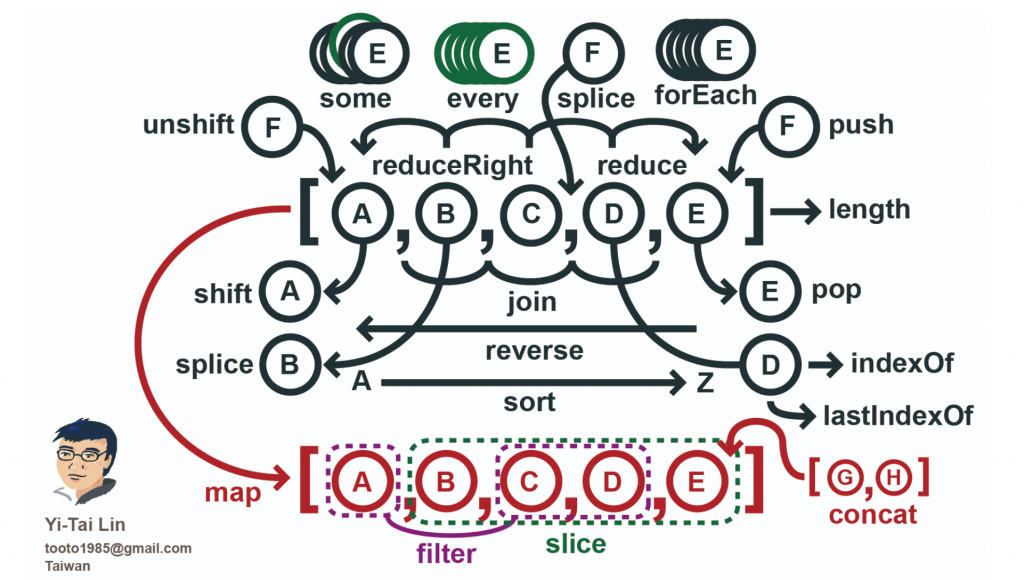
上圖是偶然看到 Tommy 大大畫的圖,覺得蠻容易理解的。
// 初始值,以下範例都會共用這個 -----
const colors = ['red', 'yellow', 'blue'];
在原本的 Array "後面"加上新值,回傳 length。所以把 push 存在變數裡 (newColor) 他竟然會回傳 Array 的長度呢!
另外 const 不能被重新指定值但 colors.push 在這裡卻不會有錯誤,為什麼呢?因為 Array 跟 Object 都是 by reference,只要不是重新指定 ( = ) 就會在同一個 reference 裡。
const newColor = colors.push('purple', 'green');
console.log(colors) // ['red', 'yellow', 'blue', 'purple', 'green']
console.log(newColor) // 5
在原本的 Array "前面"加上新值,且回傳 length
const newColor = colors.unshift('purple', 'green');
console.log(colors) // ['purple', 'green', 'red', 'yellow', 'blue' ]
console.log(newColor) // 5
移除原本陣列"最後面"的第一個值,回傳被移除掉的那個值
const newColor = colors.pop();
console.log(colors) // ['red', 'yellow']
console.log(newColor) // 'blue'
移除原本陣列"最前面"的第一個值,回傳被移除掉的那個值
const newColor = colors.shift();
console.log(colors) // ['yellow', 'blue' ]
console.log(newColor) // 'red'
把兩個陣列合併在一起,並回傳新陣列
const colors2 = ['grey', 'black', 'white'];
const newColor = colors.concat(colors2);
console.log(colors) // ['red', 'yellow', 'blue'] 原本的
console.log(newColor) // ['red', 'yellow', 'blue', 'grey', 'black', 'white' ]
// 初始值 -----
const inventors = [
{ first: 'Albert', last: 'Einstein', year: 1879, passed: 1955 },
{ first: 'Isaac', last: 'Newton', year: 1643, passed: 1727 },
{ first: 'Galileo', last: 'Galilei', year: 1564, passed: 1642 },
{ first: 'Marie', last: 'Curie', year: 1867, passed: 1934 },
{ first: 'Johannes', last: 'Kepler', year: 1571, passed: 1630 },
{ first: 'Nicolaus', last: 'Copernicus', year: 1473, passed: 1543 },
{ first: 'Max', last: 'Planck', year: 1858, passed: 1947 },
{ first: 'Katherine', last: 'Blodgett', year: 1898, passed: 1979 },
{ first: 'Ada', last: 'Lovelace', year: 1815, passed: 1852 },
{ first: 'Sarah E.', last: 'Goode', year: 1855, passed: 1905 },
{ first: 'Lise', last: 'Meitner', year: 1878, passed: 1968 },
{ first: 'Hanna', last: 'Hammarström', year: 1829, passed: 1909 }
];
回傳"第一個"符合條件的位置 index,若都找不到則回傳 -1
const findIndexEmpty = inventors.findIndex(function(item){
})
console.log(findIndexEmpty) // 沒有找到會回傳 -1
console.log(inventors) // 原本的 array
const findIndexInventors = inventors.findIndex(function(item){
return item.year > 1870;
})
console.log(findIndexInventors) // 0
// 有好幾個是 > 1800 的,但他只會回傳第一個抓到的 index
回傳一個值,且是"第一個"抓到條件為 true 的值
const findEmpty = inventors.find(function(item){
})
console.log(findEmpty) // 沒有條件會 undefined
console.log(inventors) // 原本的 array
const findInventors = inventors.find(function(item){
return item.year > 1870;
})
console.log(findInventors) // 有好幾個是 > 1800 的,但他只會回傳第一個抓到的
// { first: 'Albert', last: 'Einstein', year: 1879, passed: 1955 }
回傳一個陣列,只要條件為 true 的就會包含在此陣列,適合拿來搜尋
const filterEmpty = inventors.filter(function(item){
})
console.log(filterEmpty) // 沒有條件會 undefined
console.log(inventors) // 原本的 array
const filterInventors = inventors.filter(function(item){
return item.year > 1870;
})
console.log(findInventors)
// [{first: "Albert", last: "Einstein", year: 1879, passed: 1955}
// {first: "Katherine", last: "Blodgett", year: 1898, passed: 1979},
// {first: "Lise", last: "Meitner", year: 1878, passed: 1968}]
forEach 不會回傳任何東西,單純只執行原本陣列裡的事
const forEachInventors = inventors.forEach(function(item){
return item.year > 1870;
})
console.log(forEachInventors) // undefined, 不會 return 東西
inventors.forEach(function(item){
item.year = 1870;
})
console.log(inventors) // 全部 12 個的 year = 1870
將條件運算後重新組合回傳一個數量等於 array.length 的陣列
const mapInventors = inventors.map(function(item){
return item.year > 1870;
})
console.log(mapInventors) // [false, false, true ... 12 個]
console.log(inventors) // 原本的 array
const mapInventors2 = inventors.map(function(item){
if(item.year > 1870){
return `${item.year}歲`;
}
return false;
})
console.log(mapInventors2) // ["1879歲", false, false....]
// 不論是空的或是 false,都會回傳
回傳一個 Boolean,只要部分符合就回傳 true。它不會 Array 全部找完,只要一找到相符的直就跳出
const someInventors = inventors.some(function(item){
return item.year > 1870;
})
console.log(someInventors) // true
console.log(inventors) // 原本的 array
回傳一個 Boolean,需要全部符合才回傳 true,部分符合會回傳 false
const everyInventors = inventors.every(function(item){
return item.year > 1870;
})
console.log(everyInventors) // false
console.log(inventors) // 原本的 array
// 初始值 -----
var special = [8, 0, 14];
回傳運算結果的值。reduce 很特別,他可以與前一個回傳值做運算,先來名詞解釋一下
const reduceArray = special.reduce(
function(accumulator, currentValue, currentIndex){
return Math.max(accumulator, currentValue);
})
console.log(reduceArray) // 14
console.log(special) // 原本的 array

// 給初始值的狀況
const reduceArray2 = special.reduce(
function(accumulator, currentValue, currentIndex){
return Math.max(accumulator, currentValue);
},30)
console.log(reduceArray2) // 30

若沒有 compareFunction,會先自動 .toString() 轉成字串,回傳一個根據 Unicode 排序 array.length 長度的 array 。
特別要提得是,< 10 的 array 會是 stable 排序法, > 10 會是不穩定的排序法。後面篇章會再針對 sort 演算法做說明。
var fruit = ['cherries', 'apples', 'bananas'];
fruit.sort(); // ['apples', 'bananas', 'cherries']
var scores = [1, 10, 21, 2];
scores.sort(); // [1, 10, 2, 21]
// 跟你想的不一樣吧,因為 10 是兩個數字組成,
// 在 unicode 裡 32(數字2) > 31(1 開頭的任何數字)
var things = ['word', 'Word', '1 Word', '2 Words'];
things.sort(); // ['1 Word', '2 Words', 'Word', 'word']
若有 compareFunction 會有兩個參數 a / b, Array.prototype.sort(a, b)
function compare(a, b) {
// 若 a 比較小 排序就是 a, b
if (a is less than b by some ordering criterion) {
return -1;
}
// 若 a 比較大 排序就是 b, a 就是位置會對調
if (a is greater than b by the ordering criterion) {
return 1;
}
// 若一樣
return 0;
}
var items = [
{ name: 'Edward', value: 21 },
{ name: 'Sharpe', value: 37 },
{ name: 'And', value: 45 },
{ name: 'The', value: -12 },
{ name: 'Magnetic', value: 13 },
{ name: 'Zeros', value: 37 }
];
// sort by value 快速寫法
items.sort(function (a, b) {
return a.value - b.value;
});
// sort by name
items.sort(function(a, b) {
var nameA = a.name.toUpperCase(); // ignore upper and lowercase
var nameB = b.name.toUpperCase(); // ignore upper and lowercase
if (nameA < nameB) {
return -1;
}
if (nameA > nameB) {
return 1;
}
// names must be equal
return 0;
});
相對單純的一個方法,回傳反過來長度為 array.length 的陣列
var a = ['one', 'two', 'three'];
var reversed = a.reverse();
console.log(a); // ['three', 'two', 'one']
console.log(reversed); // ['three', 'two', 'one']
// 初始值 -----
const my_array = [5, 1, 3, 8, 6, 0]
slice 就是切,把 array 頭尾切兩刀。回傳在 start(包含) 跟 end 之間的陣列。經過 slice 後原本陣列不會改變
const sliceArray = my_array.slice(2,5);
console.log(sliceArray); // [3, 8, 6]
console.log(my_array); // [5, 1, 3, 8, 6, 0] 不會變
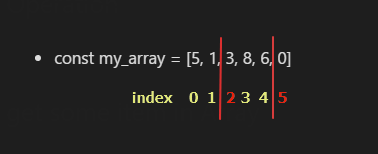
const sliceArray = my_array.slice(2);
console.log(sliceArray); // [3, 8, 6, 0]
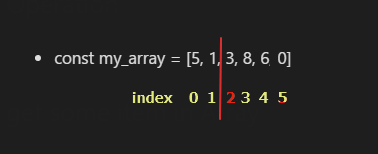
const sliceNegativeArray = my_array.slice(-1);
console.log(sliceNegativeArray); // [0]
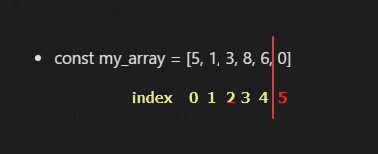
回傳被移掉的值放在陣列裡。splice 乍看下跟 slice 有點像,但其實幾乎完全相反(驚)。slice 是取 start end 裡的東西,而 splice 是 return 中間被移掉的東西。slice 不會影響本來陣列而 splice 會影響原本陣列。新增的 item1、item2 只會影響本來陣列,並不會回傳到新的陣列裡
splice 是拼接的意思你不但可以切掉某塊還可以塞東西進去。
// 假如只有 splice(start),這時會跟 slice 行為一樣
const spliceArray1 = my_array.splice(3)
console.log(spliceArray1); // [8, 6, 0] 被移掉的值
console.log(my_array); // [5, 1, 3],index 3 後面都移掉
//一樣可以接受負數
const spliceArray2 = my_array.splice(-1)
console.log(spliceArray2); // [0]
console.log(my_array); // [5, 1, 3, 8, 6] 倒數 1 個後面都移掉
// splice(start, deleteCount 抓幾個)
const spliceArray3 = my_array.splice(1, 3)
console.log(spliceArray3); // [1, 3, 8]
console.log(my_array); // [5, 6, 0]
// 從 index 1 開始抓 3 個 把中間值移掉
// splice(start, deleteCount 抓幾個, 插入 item)
const spliceArray4 = my_array.splice(1, 3, 'Hana', 'Mike')
console.log(spliceArray4); // [1, 3, 8]
// 不會有 'Hana', 'Mike' 字眼出現
console.log(my_array); // [5, "Hana", "Mike", 6, 0]
// 從 index 1 開始抓 3 個 把中間值移掉 並塞進 "Hana", "Mike"
回傳所在位置的 index,如果找不到會回傳 -1
const indexArray = my_array.indexOf(3) // 2
console.log(indexArray) // 2
console.log(my_array) // [5, 1, 3, 8, 6, 0]
const indexArray2 = my_array.indexOf(100)
console.log(indexArray) // -1
把所有陣列裡的值加上 separator,回傳一個字串
const joinArray = my_array.join('-') // 2
console.log(joinArray) // '5-1-3-8-6-0'
console.log(my_array) // [5, 1, 3, 8, 6, 0]
const joinArray2 = my_array.join('') // 2
console.log(joinArray2) // '513860'
看 searchElement 有沒有在 array 裡,回傳 Boolean
const includesArray = my_array.includes(3)
console.log(includesArray) // true
console.log(my_array) // [5, 1, 3, 8, 6, 0]
my_array.includes(5,3) // false 從 index 第三個之後找 5
最後做一個表讓自己更清楚,喜歡下表的人我也提供 gitbook 連結你可以當 bookmark 查找比較方便 (有 Array Method 跟 String Method)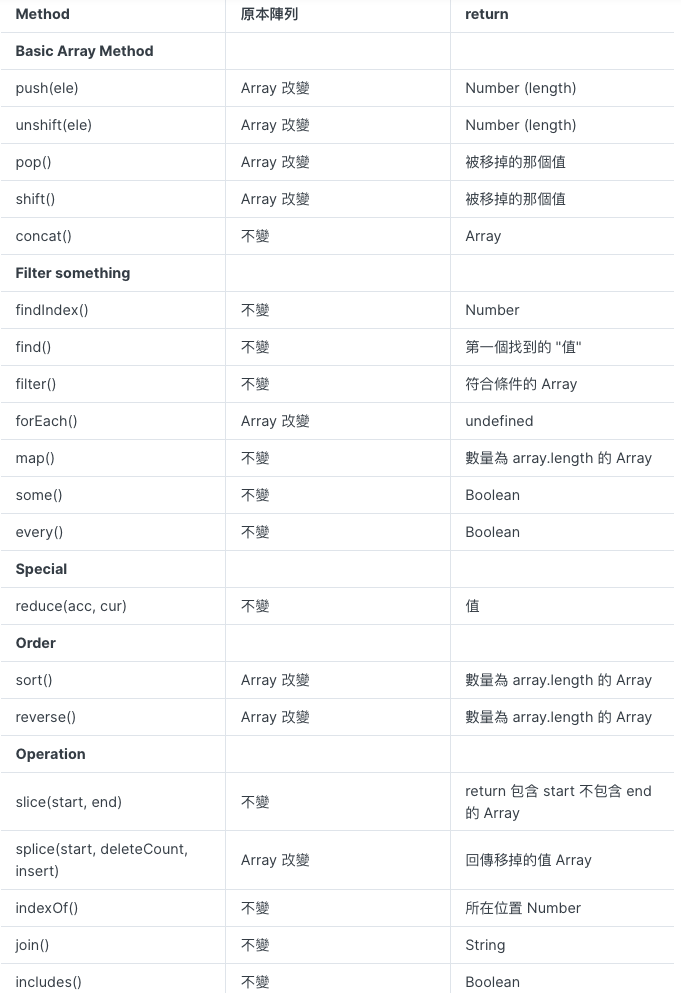
今天內容有點多
如有錯誤或需要改進的地方,拜託跟我說。
我會以最快速度修改,感謝您
歡迎追蹤我的部落格,除了技術文也會分享一些在矽谷工作的甘苦。

媽,我上別人的鐵人賽了!
這主題太讚了,一定要完賽喔!
加油!
竟然瞬間釣到做圖原作者大大高手
真的很棒,感謝兩位大大!
程式碼 const 少了一個c
這邊的 currentValue 應該是 14 (我不確定)
表格整理的很讚
感謝糾正,馬上改
很喜歡妳寫的文章,非常淺顯易懂好理解
不過讀到這一段的時候有點跳針 XD
應該是「slice 是取 start end 裡的東西」唷!
對我真的寫錯了 馬上改,謝謝你的糾正
太感謝了!整理的非常清楚易懂!
最後的整理表格中,filter() return 應該是陣列?

不是陣列唷,是值沒有錯。
以JSON來說,一個物件 XD
有點不懂為什麼是值?不是陣列?
抱歉很久沒來這裡查看留言了
filter() return 應該是陣列
也把圖更新囉
哈 沒想到原作會出現。
剛好路過看到留言覺得奇怪。